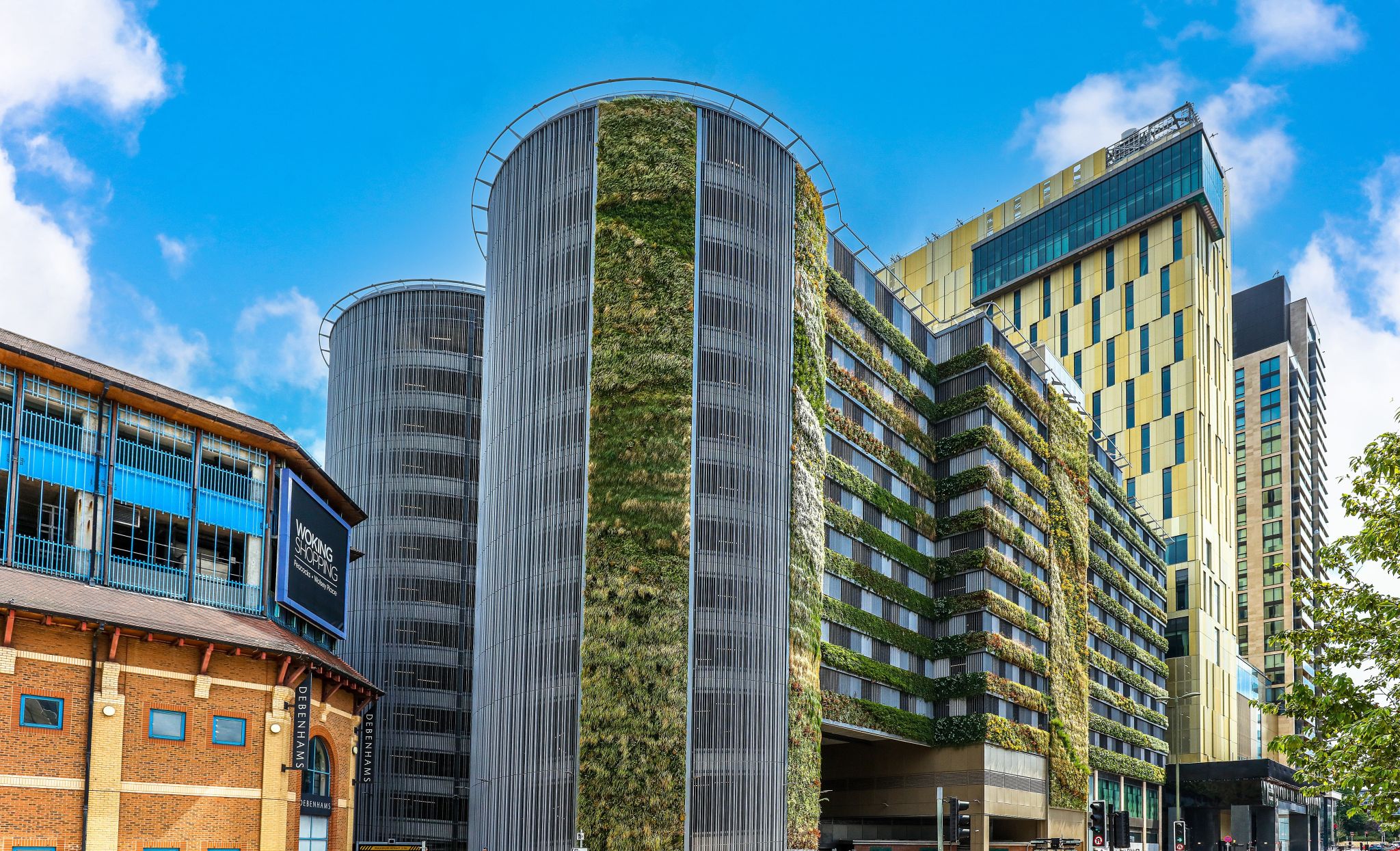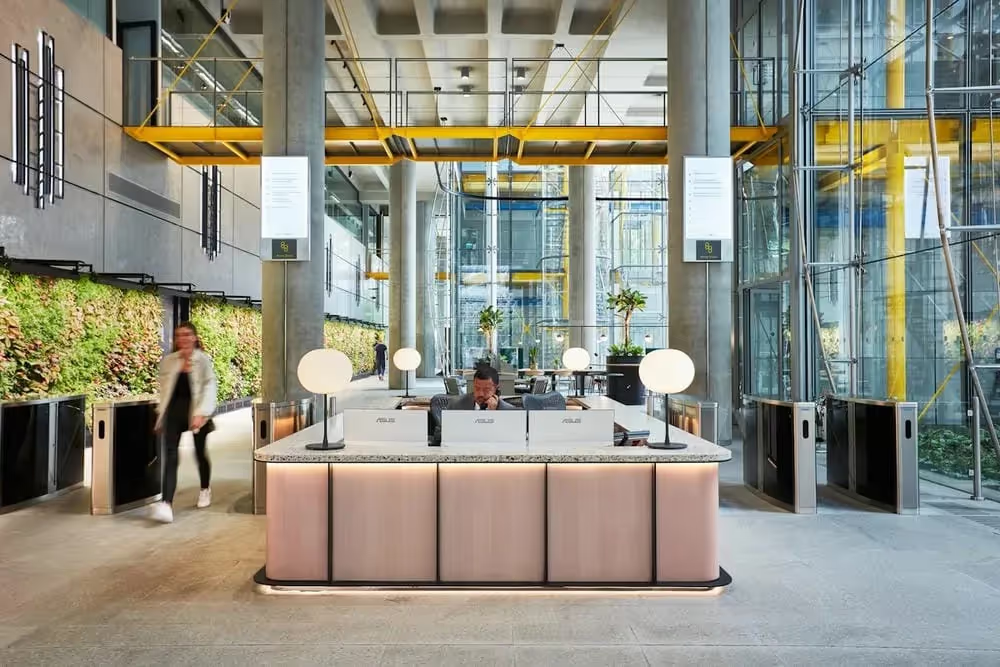Using Living Walls on Multi-storey Car Parks to Create Environmental Assets

Buildings and built structures are a vital component of modern-day society, playing a multifaceted role in our lives. They serve as spaces for living, working, learning, and recreation. Beyond their functional aspects, buildings also shape the aesthetic and cultural fabric of our communities.
However, according to the World Green Building Council, buildings are responsible for 39% of global energy-related carbon emissions of which 11%, comes from the construction, maintenance, and eventual demolition of these buildings.
So, what can councils do to reduce the impact their built structures have on the environment, yet still provide functional and usable spaces?
Greener Parking: Using Living Walls and Green Roofs to Enhance the Sustainability of Multi-storey Car Parks
Transport is crucial for the economy and gives us freedom. However, transport and traffic pose challenges in the areas of public health and climate change.
Despite the fact that modern technologies make transport safer, smoother, and cleaner; traffic between cities is becoming increasingly intensive and the number of vehicles is growing. To house the growing number of vehicles on the road, multi-storey car parking facilities have been built as an effective solution.
Multi-storey car parks make up around 6,000 of all built structures in the UK alone, and this number is projected to rise further in response to the growing number of cars on the roads. Unfortunately, cars themselves are significant contributors to carbon emissions, and the construction and operation of conventional car parks further exacerbate the environmental impact.
These structures typically rely on non-renewable materials like concrete and steel, resulting in substantial carbon emissions throughout their life cycle, from manufacturing to construction and eventual demolition. Moreover, the construction of car parks often involves the removal of trees and natural spaces, depriving local areas of crucial ecosystems and greenery.
In the quest for more sustainable urban development, the concept of "Greener Parking" has emerged as a promising solution to enhance the environmental performance of multi-storey car parks.

What Are Green Car Parks?
Green car parks such as the one at Victoria Way in Woking, are parking facilities specifically designed to minimise their environmental impact and promote sustainability. These car parks employ various strategies and technologies to achieve their green objectives, such as:
- Utilising LED lighting systems and implementing motion sensors to ensure lights are only activated when necessary.
- Incorporating renewable energy sources such as solar panels on rooftops or carport structures, allowing them to generate their own clean energy.
- Promoting alternative modes of transportation by providing dedicated spaces for bicycles, electric vehicle charging stations, and even facilities for car-sharing programs.
- Installing green/ living walls and roofs to the existing structures to reduce water consumption, improve air quality, and restore biodiversity.
In this article, we will be looking specifically at the environmental benefits of installing green roofs and living walls to multi-storey car parks.
Living Wall and Green Roof Applications on Multi-storey Car Parks: The Benefits
Living walls and roofs have become a prominent feature of ethical design and are crucial for staying on top of ecological requirements. Installed onto otherwise wasted wall and roof space, they can transform even the most unlikely structure into a thriving oasis that offers a wealth of benefits; from improving general health and well-being to supporting biodiversity.
For car parks, in particular, living walls and roofs are especially beneficial due to the unique challenges they present. These benefits include:
Temperature Regulation:
As multi-storey car parks are often located in city centres, where the heat island effect is pronounced, the integration of these green features becomes crucial. Living walls and green roofs act as natural temperature regulators, helping to mitigate the heat island effect by reducing surface temperatures and absorbing solar radiation. This, in turn, creates a cooler microclimate within the car park and its surroundings, providing a more comfortable experience for users and minimising the need for energy-intensive cooling systems.
Improved Air Quality:
Covered with a variety of native live plant species, green infrastructure such as living walls and roofs are able to filter out up to 95% of the pollutants generated by vehicles and industry.
Research has shown that 1m² of vegetation cover generates the oxygen required by a person throughout the year whilst trapping 130g of dust annually. Another study in 2012 highlighted how vegetation in the streets was able to reduce street-level concentrations by as much as 40% for NO2 and 60% for particulate matter (PM).
By implementing these green features, car parks can contribute to cleaner air in urban areas, mitigating the negative effects of vehicular emissions.
Enhanced Aesthetics:
Living walls and green roofs bring a touch of nature to otherwise concrete-dominated structures. The vibrant plant life adds visual appeal and softens the appearance of the car park, creating a more pleasant and welcoming atmosphere for users and surrounding communities.
Stormwater Management:
Green roofs and living walls play a crucial role in rainwater management and irrigation within multi-storey car parks. By absorbing and retaining rainwater, these features help reduce stormwater runoff, mitigating the strain on urban drainage systems and minimising the risk of flooding.
Green roofs and living walls are designed with layers that include a waterproof membrane, a drainage layer, a filter fabric, and a growing medium where the plants are rooted. This system allows them to capture rainwater, which is then absorbed by the plants and the growing medium. The plants utilise the water for their growth and transpiration, effectively reducing the volume and velocity of stormwater runoff.
Similarly, these living walls and roofs have built-in irrigation systems that distribute water to the plants through a network of pipes or drippers. These systems can be designed to harvest rainwater, further optimising water conservation efforts.

Biodiversity Gain:
With the prevalence of concrete, steel and glass in cities, nature is confined to small pockets of green space.
By adding biodiverse green roofs and walls to car parking facilities, cities can massively increase the habitats available to birds, bees, butterflies, and insects.
Specific soil and plant mixes can be used to bring local plants back to the environment and other features such as log piles, recycled aggregates, rocks, bird baths, insect hotels, rope coils and beehives can be included to create additional micro-habitats to boost the positive environmental impact of the living walls and roofs.
Community Well-being:
The concept of biophilia emphasizes our inherent connection and attraction to nature, which has a positive impact on our well-being. When we seek relaxation or stress relief, nature often becomes our refuge.
In urban areas where green spaces are limited, roofs and walls present an untapped opportunity to reintroduce nature and provide spaces that benefit building occupants and the local community alike.
By transforming rooftops and façades into vibrant green oases, car parks can tap into the power of biophilia, creating environments that enhance relaxation, offer respite, and improve overall well-being. These green spaces not only benefit building occupants but also contribute to the surrounding community, providing a much-needed connection to nature in urban settings.
Green Infrastructure for Multi-Storey Car Parks from the Experts
Here at Viritopia, we are experts at providing buildings such as multi-storey car parks with integrated living wall solutions that have been carefully designed, installed, and maintained over the past 15 years.
Focussing on improving biodiversity, reducing emissions, and meeting structural regulations, our living walls and roofs are a turn-key solution to creating immense environmental assets for cities and communities across the globe. Explore our range of green parking living wall and roof case studies to see the benefits for yourself.
Whether you’re looking to improve the air quality of your space, like the idea of connecting with nature, or would like to increase the value of your property, contact our team today – we’re always happy to talk and would love to discuss your requirements.
Explore more insights
Discover the latest in green infrastructure

Vanguard Logistics Park (Longmore) Featured in RIBA Commercial Directory 2025

Green Roof Advantages & Disadvantages

Design with meaning: How office living walls reflect your brand

